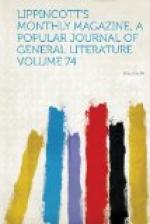Our state-room was on the main deck, with a good-sized window admitting plenty of light and air, and the side of the ship was not so high but we could see over and have a fine view of the high rocky coast we were skirting—so much pleasanter than the under-deck state-rooms, where at best you only get a breath of fresh air and a one-eyed glimpse out of the little port-holes in fine weather, and none at all in a storm. Imagine, therefore, my disgust when, on returning from our trip on shore at Corfu, I found twilight pervading our delightful state-room, caused by an awning being stretched from the edge of the deck overhead to the side of the ship, and under this tent, encamped beneath my window, the lesser wives, children and slaves of an old Turk who was returning to Constantinople with his extensive family! His two principal wives were in state-rooms down below, and invisible. Well, if I had lost the view from my state-room of the grand mountainous coast of Greece, I had an opportunity of studying one phase of Oriental manners and costume at my leisure. There were three pale, sallow-looking women of twenty or twenty-five years of age, with fine black eyes—their only attraction; two old shriveled hags; four fat, comfortable, coal-black slave-women; and several children. They had their fingernails colored yellow, and all, black and white, wore over their faces the indispensable yashmak, and over their dress the ferraja, or cloak, without which no Turkish woman stirs abroad. As it was cold, they wore under their ferrajas quilted sacques of woolen and calico coming down below the knee, and trousers that bagged over, nearly covering their feet, which were cased in slippers, though one of the negresses rejoiced in gorgeous yellow boots with pointed toes. The children had their hair cut close, and wore their warm sacques down to their feet, made of the gayest calico I ever saw—large figures or broad stripes of red, yellow and green. The boys were distinguished by red fez caps, and the girls wore a colored handkerchief as a turban. They covered the deck with beds and thick comforters, and on these they constantly sat or reclined. When it was absolutely necessary a negress would reluctantly rise and perform some required act of service. They had their own food, which seemed to consist of dark-looking bread, dried fish, black coffee and a kind of confectionery which looked like congealed soapsuds with raisins and almonds in it. Most of their waking hours were employed in devouring oranges and smoking cigarettes.
We had rough weather for several days, and the ship rolled a good deal. The captain made us comfortable in a snug corner on the officers’ private deck, where, under the shelter of the bridge, we could enjoy the view. One amusement was to watch the officer of the deck eat his dinner seated on a hatchway just in front of the wheel, and waited on by a most obsequious seaman. The sailor, cap under his arm, would




